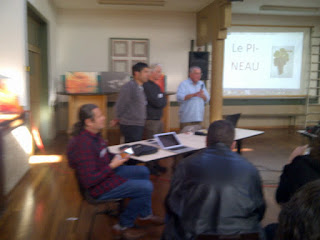This Blog is 'A plea for Diversity in Wine.' Three years ago we heard about an annual meeting in SW France called 'Rencontres des Cepages Modestes.' We were immediately drawn to the idea of attending this event as it promised a really serious survey of diverse varieties from the growers' point of view as well as the consumer's. Two years passed when events prevented us from making the pilgrimage but in 2015, the opportunity arose to attending one of the two days of lectures, meetings and tastings.
The name itself had its charm. 'Cepages modestes' seemed so French with what seemed its connotations of hierarchy and snobbism. That was a false impression; the term 'modestes' it was explained refers to the amount of plantings rather than any value judgement.
The Rencontres were founded by a famous French wine writer, Philippe Meyer who is also widely known as a TV personality with his own programme on wine. Due to the fact that he comes from St. Come d'Olt in the Lot et Garonne the event is held there. St. Come d'Olt is described as a place of which you think 'Why go there?' and when you are there, 'Why don't we come more often.' It is difficult to get to particularly from abroad but there are practically no foreign visitors. Indeed apart from an Italian delegation invited to expound on the cepages modestes of Piemonte we were the only ones.
The word Pilgrimage is apposite. St. Come seems still to be a stop on the pilgrimage to Santiago de Compostela. In the beginning of November its aspect is a tad mournful but no doubt in summer it must be rather attractive.
 |
| The Salle des Fetes, St. Come d'Olt, venue of the Rencontres |
The first and only full day included presentations on Pineau d'Aunis (one of our favourite cepages) and on Savoie where so much interesting work has been done to revive varieties such as Persan and Gringet by the Grisard family and others, already celebrated in this blog.
There were plenty of celebrated Vignerons there. We were able to identify Robert Plageoles, Michel Grisard, Thierry Navarre, Eric Nicholas and Nicolas Gonin but most of the others were obviously also vignerons; gnarled chaps with stained hands mostly of a certain age it has to be said.
 |
| Henri Galinie (left) and Jean Rosen |
The atmosphere was convivial. The presentations serious and informative. Presiding with easy bonhommie were Jean Rosen, 'Directeur de recherche au Centre National de Recherche Scientifique,' Dijon and Henri Galinié, retired director of the CNRS at Tours who is principally an archeologist specializing in the middle ages. These two gentlemen wear their formidable learning and authority lightly. Jean Rosen, the organizer of the Cepages was able to fill in for a last minute withdrawal at short notice. Henri Galinié is the treasurer as well as being one of the best lecturers of the event. Amazingly his Wikipedia entry makes no mention of any interest in vines or wine.
 |
| Henri Galinié on Pineau d'Aunis |
Pineau D'Aunis was the subject of Saturday morning. Henri Galinié dismissed the fable that it was the favourite variety of Henry III (Plantagenet) in masterly fashion. Not only was he able to assert that Henry's imports of wine from France didn't specify even the colour of the wine but that the fiction was the work of a specific person at a specific date. Wonderful stuff.
 |
| Eric Nicolas of Domaine de Belliviere |
Two growers including Eric Nicolas of the famous Domaine de la Belliviere were then given the floor and we learned about their experiences with this grape.
 |
| before the onslaught |
 |
| two hours and still at it |
After a buffet lunch lasting 2 hours we settled down to a survey of the renaissance in the varieties of Savoie.
 |
| Michel Grisard |
Michel Grisard's researches have resulted in an increase from 10 only a few years ago to over 30.. he finds extinct varieties not in vineyards where they have been eliminated but in private gardens, plots and even growing up the walls and on the terraces of houses.
 |
| Nicolas Gonin |
The growers following his talk included Nicolas Gonin (Domaine Nicolas Gonin). He is no less a researcher than Grisard. His plantings include Mècle, Persan, Verdesse, Bia Blanc and Servanin.
 |
| Robert Plageoles |
The discussion was then given to the floor and we heard notably
from Robert Plageoles. At first we thought his strongly accented
Gaillacois interventions were from some peasant farmer but it really was
the great internationally celebrated Plageoles himself, discoverer and
revivalist of no less than 7 types of Mauzac as well as another half
dozen varieties including Ondenc, and Prunelart.
Someone
asked Plageoles of his work with wild woodland varieties had produced
any good wine to which he replied with an emphatic 'non'. However he
believes his work might be crucial in providing a new rootstock on which
to graft vines in the case of a future plague of a vine disease like
Phylloxera one day. He made a plea to 'les jeunes' to continue this kind
of research before it is too late.
 |
| Thierry Navarre |
There was a lot of talk about the Vassal collection and plans to move it to Montpelier which everyone said could not be done without losing a large quantity of the plants due to the different terroir etc. Everyone was up in arms about that one.
So, something unique and interesting all-in-all and a privilege to be in the company of so many pioneers and preservers of vanishing varieties. What a contrast to the world of Grand Cru brands and industrial wines. We may not be in a rush to return but the Rencontres definitely comes under the category of 'vaut le voyage'.
 |
| Thierry Navarre wines |


















